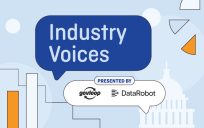Artificial intelligence (AI) has the potential to find valuable new insights in your data. But to make the most of it, your data, and your organization, must be ready.
“When change occurs, I typically look at that three-point triangle: processes, people and technology,” said Winston Chang, Chief Technology Officer for Global Public Sector at Snowflake, which provides a single, global platform that powers the data cloud. “In government, we just got used to DevSecOps, and now we’ve got this new thing to learn. But data ops are so critical to AI and machine learning,” he said.
Good data governance — how you manage the security, accessibility, usability and integrity of your data — is the essential underpinning for effective use of AI. “It’s the culture around data hygiene, the quality of the data, the way we collect it, how we keep it clean.”
“Your data operations, your ML [machine learning] operations, your training of your people — those are the fundamentals of everything,” he said. “Get your data governance set up. Do your hygiene. Don’t even worry about the AI until you get the fundamentals right.”
Work Across Silos
A persistent issue is that data often is spread across multiple locations, and each may use different applications. What organizations are looking for now is a way to make the data and applications work across the enterprise — abstracting those layers and making them interoperable.
If you can access data across the silos, Chang explained, you can get a much greater depth of analytics. “But the difficulty of that is you have to be able to accept all types of data. And you have to be able to run all the different types of workloads against those data.”
Use AI to Make More Data Accessible
Most agencies have documents that aren’t formatted for databases. “There’s a ton [of information] sitting there in grant proposals, RFPs, RFIs…any kind of report or analysis. That’s all unstructured data,” Chang said.
Large Language Model (LLM) AI can make that data useful. “This is the least sexy thing you would use an LLM for, but it’s probably the biggest value add across the board. It can take unstructured data and translate it into relational data. And then all of a sudden that data is useful to us. Fundamentally it would make a huge difference in the federal government,” Chang said.
AI also has the power to shift analytics from descriptive — for example, how many people are receiving a specific benefit — to predictive. In one agency, HR used predictive analytics to anticipate attrition and identify types of employees most likely to leave. AI also helped the department determine what programs could influence people to stay.
It Comes Down to People
“Getting the data operations right is the first layer. But that’s not a technology question. It’s a process and person question. We can help, certainly, with tools that make things easier. But it ultimately is an organizational choice and discipline.”
This article appears in our new guide, “AI: A Crash Course.” To read more about how AI can (and will) change your work, download it here:






Leave a Reply
You must be logged in to post a comment.